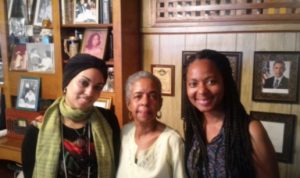Blog Blog Day 1 – June 25, 2018 Blog Day 2 – June 26, 2018 Blog Day 3 – June 27, 2018 Blog Day 4 – June 28, 2018 Blog Day 5 – June 29, 2018 Blog Day 6 – June 30, 2018 Blog Day 7 – July 1, 2018 Blog Day 8 – July 2, Read More ...

ICRPS 2018 Summer Institute | Tuskegee, AL | June 24-July 07
"Social Justice, Rural and Natural Resource Policy"
Written by: Sherine Salmon & Dalal Alkordi
 How many bubbles do you think is in that bar of soap? How many jelly beans do you think is in the jar? These were the type of questions in the literacy test for African Americans when they tried to register to vote (intimidation). Day 5 of ICRPS focused on the historic sites of Selma and Epes. March 7, 1965 in Selma, Alabama, dubbed ‘Bloody Sunday’, saw the historical march along the Edmund Pettus Bridge that provided the right for blacks to vote. This march was motivated by their constant denial to partake in the ‘democratic’ system of the United States of America, along with the shooting and subsequent, death of Jimmie Lee Jackson. The walk across the bridge led us to the site, now called the Civil Rights Memorial Park, where police brutality was enacted upon the activists. ‘Someone marched for me’ were the lyrics that accompanied the tune that played throughout the visit at The National Voting Rights Museum. The museum sought to highlight the work of the foot soldiers – the unsung heroes who never counted their lives too important in light of the greater goal – whose unwavering stance proved successful. Their sacrifice could only be rewarded by the announcement of the 1965 Voting Rights Act, signed on August 6 of the said year. The visit to the Selma Interpretative Center, afforded us the opportunity to meet Mayor Darrio T. Melton, who gave us insight on the current projects of the town as well as the needs of the community. The visit to this center further highlighted key players in the movement towards equal rights to vote for African Americans. The joint efforts of the Courageous Eight (Mrs. Amelia Boynton, Mrs. Marie Foster, Mr. Ernest Doyle, Rev. John D. Hunter, Mr. James Gildersleeve, Rev. Henry Shannon, Mr. Ulysses Blackmon, and Dr. Frederick D. Reese) of the Dallas County Voters League (DCVL), the Southern Christian Leadership Conference (SCLC) and Student Nonviolent Coordinating Committee (SNCC) led to the evolution of social systems. We were then hosted for lunch at the Wallace Community College.
How many bubbles do you think is in that bar of soap? How many jelly beans do you think is in the jar? These were the type of questions in the literacy test for African Americans when they tried to register to vote (intimidation). Day 5 of ICRPS focused on the historic sites of Selma and Epes. March 7, 1965 in Selma, Alabama, dubbed ‘Bloody Sunday’, saw the historical march along the Edmund Pettus Bridge that provided the right for blacks to vote. This march was motivated by their constant denial to partake in the ‘democratic’ system of the United States of America, along with the shooting and subsequent, death of Jimmie Lee Jackson. The walk across the bridge led us to the site, now called the Civil Rights Memorial Park, where police brutality was enacted upon the activists. ‘Someone marched for me’ were the lyrics that accompanied the tune that played throughout the visit at The National Voting Rights Museum. The museum sought to highlight the work of the foot soldiers – the unsung heroes who never counted their lives too important in light of the greater goal – whose unwavering stance proved successful. Their sacrifice could only be rewarded by the announcement of the 1965 Voting Rights Act, signed on August 6 of the said year. The visit to the Selma Interpretative Center, afforded us the opportunity to meet Mayor Darrio T. Melton, who gave us insight on the current projects of the town as well as the needs of the community. The visit to this center further highlighted key players in the movement towards equal rights to vote for African Americans. The joint efforts of the Courageous Eight (Mrs. Amelia Boynton, Mrs. Marie Foster, Mr. Ernest Doyle, Rev. John D. Hunter, Mr. James Gildersleeve, Rev. Henry Shannon, Mr. Ulysses Blackmon, and Dr. Frederick D. Reese) of the Dallas County Voters League (DCVL), the Southern Christian Leadership Conference (SCLC) and Student Nonviolent Coordinating Committee (SNCC) led to the evolution of social systems. We were then hosted for lunch at the Wallace Community College.
Our trip had a very special stop after lunch at the Jackson House which held the spirit of Martin Luther King Jr. and his importance to the voting rights act; this is the place where he had meetings and spent his time while in the south. Each corner and room of this house had an interesting story. After the amazement with the Jackson house, we had the pleasure to visit the church where Dr. King worshipped and had some speeches, the Brown Chapel AME Church. It was established in 1908 and interestingly was built by black architects. This church played a vital role in the civil rights movement and nonviolence revolution, especially in the march of Bloody Sunday. Since 1960 people started gathering inside the church for these causes. In 1997, the church was named a historic landmark.
Despite the long day and the heat on our heads, we were so excited for our second trip to Epes, Alabama. Once we made it to the Federation of Southern Cooperatives Training Center, we were warmly welcomed by Marcus Bernard, the director, and his employees. We enjoyed wonderful food while learning about the different kinds of collaboration and assistance done by the Cooperatives with regard to land loss issues. The cooperative as a nonprofit organization addresses small black farmers’ business struggles. The cooperatives’ main principles are (land, labor, capital, and, management). The documentary viewed acknowledged that African American farmers are in need of more knowledge, technical assistance and how the cooperatives make decisions to help create new jobs. We also discussed and explored information on the socio economic conditions that depress almost all the Black Belt Counties. We felt proud at the end of the day when we learnt about the successful collaboration between Tuskegee University and the Federation (zero sum game).
Photo display of the ‘Bloody Sunday’ march; Selma Interpretative Center
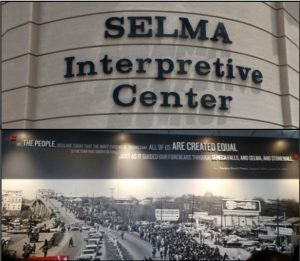
Foot molds of actual foot soldiers of the ‘Bloody Sunday’ march; The National Voting Rights Museum
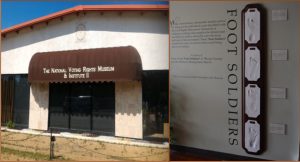
Monuments of 4 of the Courageous Eight along with the founders of the Civil Rights Memorial Park
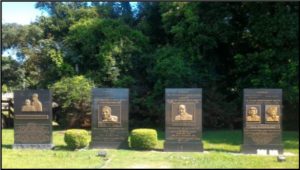
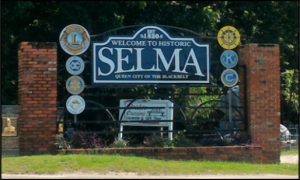
Edmund Pettus Bridge
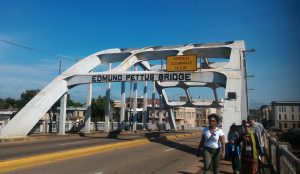
From Left: Dalal, Joanna Jackson, Sherine; The Jackson House
